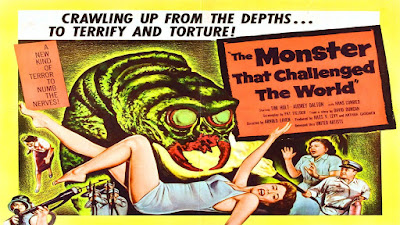
A somewhat predictable and formulaic sci-fi film which has enough action to hold audience interest for much of the 83 minutes viewing time.
Directed by Arnold Laven
Produced by Arthur Gardner, Jules V. Levy
Screenplay by Pat Fielder
Story by David Duncan
Music by Heinz Eric Roemheld
Cinematography: John D. Faure
Edited by Lester White
Production company: Gramercy Pictures, Inc.
Distributed by United Artists
Running time: 83 minutes
Budget: $200,000
Cast
Tim Holt as Lt. Cmdr. John "Twill" Twillinger
Audrey Dalton as Gail MacKenzie
Hans Conried as Dr. Jess Rogers
Harlan Warde as Lt. Robert "Clem" Clemens
Max Showalter as Dr. Tad Johns
Mimi Gibson as Sandy MacKenzie
Gordon Jones as Sheriff Josh Peters
Marjorie Stapp as Connie Blake
Dennis McCarthy as George Blake
Barbara Darrow as Jody Simms
Robert Beneveds as Seaman Morty Beatty
Charles Herbert as Boy with Morty's Cap
Jody McCrea as Seaman Fred Johnson
Wallace Earl as Sally as Eileen Harvey
Trailer
Classic Sci-Fi Film Stew
Spoilers follow below....
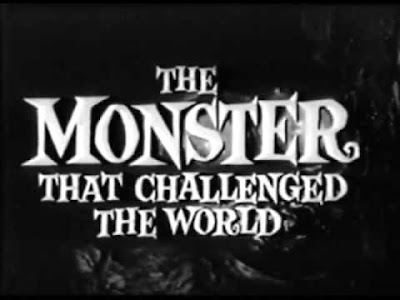
Ingredients
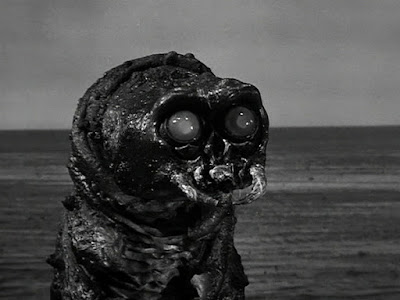
- A central unoriginal premise involving giant molluscs that emerge from California's Salton Sea and pose a threat to life on earth. (Ants, huge locusts, giant spiders, supersized praying mantises could just as easily be served as substitutes.)

- A protagonist, in this case, a Lt. Cmdr. John "Twill" Twillinger military variety with a crusty outer skin concealing a soft centre.
- A large dose of fairly forgettable dialogue.

- A rather sugary sweet beautiful and available love-interest in the form of Gail MacKenzie
- An annoying little girl and a couple of pesky little boys.
- Assorted naval and scientific characters.

- A disposable young couple or two.
- A handful of old geezers.
- A sympathy-evoking, expecting and soon to be widowed woman.
- A narrator.
- A Salton Sea setting for flavour. (Any number of isolated desert locales could also be used in a pinch)
- An earthquake or two.
- The usual requisite informative film.
- A half dozen or so giant eggs.
- A variety of finely chopped high and low plot points.
Total Cost: $200,000 [Great when you’re on a budget!]
Serves: Any number of undemanding classic sci film fans.
Method
Stage 1: The Opening
[In the opening sequence of putting together our sci-fi stew, we will attempt to mix in a kind of an unusual scientific phenomenon that defies our conventional notions of how Nature is supposed to work. If done correctly, these new laws or rules of nature will set almost immediately and remain so throughout the rest of the film.]
- Roll title and credits over a night view of the Salton Sea in California.
- Next, prepare an aerial view shot of the Salton Sea during the daytime.
- Place a narrator at this point to set the scene for us by informing us that;
"This is the Salton Sea in Southern California. A strange phenomenon in which nature has placed 400 square miles of salt water in the middle of an arid desert. In the desert, close to shore of the sea, the government has established one of its most important Naval Research Bases. At the laboratory on the secluded south tip of the base, top secret atomic experiments are carried out under rigid security controls."
Tip: Don’t let the “Research” and “Atomic” ingredients put you off this dish. They are an essential component of any good sci-fi film stew.
- Unleash an underwater earthquake in the Salton Sea, causing a fissure to open.
- Follow this up by giving the base a good shaking with
- an earthquake.

- Introduce a parachute jump over the sea and then spoon out a patrol boat to recover the parachutist.
- At this point add a pinch of mystery by having the recovery team locate only the parachute.
- Next, have one of the team dive into the water to search for the missing man but don’t allow him to resurface!

- Follow this up by having the remaining sailor being confronted by what we see only as a shadow that causes him to scream as he is stricken with horror.
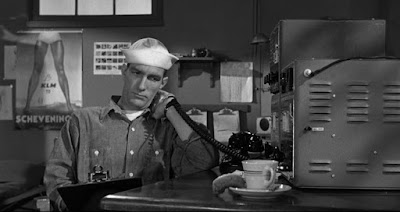
- End this stage of the process with the land radio operator attempting to re-establish contact with the patrol boat.
Stage Two:
[At this stage of the process, you’ll be confronting the protagonist with a lethal consequence of this unusual scientifically unnatural phenomenon. The protagonist will be forced to realise something unnatural is going on and that it will have to be dealt with.]
- When the patrol boat fails to answer the radio calls, introduce the Lt. Cmdr. John "Twill" Twillinger ingredient by having him lead a rescue party on a patrol boat to investigate.

- Next, ensure that the rescue party locates the deserted patrol boat containing the dead body of seaman Sanders and be sure to lightly coat the port side of the boat with a strange slimy substance.

- If all has gone well, at this point the parachutist’s body should float to the surface, with its skin darkened and be completely drained of bodily fluids.
- While this is being left to simmer, thoroughly combine the following characters: Twill, Gail MacKenzie and Dr. Jess Rogers for later use.
- Once the analysis of the substance is complete back at the lab, ensure that Dr. Rogers will have determined that it is just a marine secretion while the Coroner Nate Brown concludes that;
- a puncture wound as being Hollister’s (the parachutist) cause of death and that his body has been inexplicably drained of blood and water.
- a stroke as being the cause of Sander’s (the sailor on the boat) death due to extreme excitement or fear.
It is also recommended that that George Blake notices that the white substance is radioactive.

- Take a disposable young couple, Jody Simms and her boyfriend Seaman Morty Beatty, and have them go missing after a swim.
- Follow this up with two pesky boys fighting over a sailor's cap.

- Next, have one of the tow-headed brats take Twill to the place where he found it.

- Allow Twill to discover the seaman's and Jody's clothing.
- While Jodie’s mother, Mrs. Simms sobs with grief, ensure that a liberal coating of the radioactive white substance is placed on the rocks for Twill to come across. This will help to thicken the plot.

- As soon as the plot thickens, use your egg-beater to mix a couple of divers, Dr. Johns and George Blake, a giant spherical egg and the body of one of the victims. As you do so, carefully monitor the radioactivity readings: (At 60 feet everything should be normal.)
- At 125 feet at the bottom of a canyon there should be a large white balloon-like radioactive sphere.
- This sphere must be cut loose and sent to the surface.
- Now ramp up the tension by;

- revealing the shrivelled body of Jody Simms
- having a large marine monster attack and kill Blake.
- Next, spare Dr. Johns so that he can swim for the boat and inform the others about the creature.

- Before proceeding to the next stage, the creature will need to surface and attack the boat where Twill stabs it in the eye with a grappling hook causing the creature to sink back into the water and settle at the bottom of the sea.
[For this stage, the events are to lead toward a confrontation between the protagonist and the unnatural phenomenon or antagonist which threatens to destroy both the film’s hero and the world. You will have to work quickly here as the action rises and builds up to a final climax. Get it wrong and the sci-fi film stew will surely turn into a pot of runny slop!]
- First of all, transfer the spherical egg to the U.S. Navy lab for investigation and have it kept under temperature control to prevent it from hatching.
- Secondly, tug on the audience’s heart strings and stir a sense of outrage by making sure that Connie gradually learns about the fate of her husband. Her fate: widowed and pregnant.
- Thirdly, whisk up a plan to kill the creature with depth charges.
- Next, go back to the incubating egg at the lab and keep the temperature of the water in which it is immersed at exactly 38 degrees in order to control its growth.
- Finally, it is time to introduce plausible-sounding information by running a film featuring molluscs together with presenting photographic evidence suggesting that at least ten other creatures exist that will need to be destroyed.
Having done this, add the following ingredients needed to string out the audience with a series of high and low points in the plot:
- a man discovered covered with the white substance, stumbling in distress and rambling something about "Mary Jean."
- reports of shrivelled livestock.
- deductions concerning the existence of a possible underground river connecting the Salton Sea to the canal system.
- an old map from the Imperial County Museum revealing nothing useful.
- lock keepers checking in with the base but not reporting any sightings with the exception of some boys splashing in the canal.
- young Sandy (while her mother is talking on the phone) adjusting the temperature on the incubating egg in the lab thinking it will warm the room for the rabbits.

7. the watchman at Lock 57 hearing something outside, assuming once again it is kids and being attacked by the creature when he investigates.
8. Twill and Dr. Rogers spotting from a helicopter a small lake with the white foam-like substance floating on the surface.
9. Twill diving with Dr. Johns and planting explosive charges near the shells of dormant creatures.
10. Explosions as the two divers ascend and make it to shore.
Final Stage:
[Prior to putting your stew on to cook, top it off with a climactic battle in which the hero-protagonist vanquishes the creature.]
In this final stage,
- Ensure that Twill calls the lab but receives no answer.
- Have Sandy sneaking into the lab while her mother is on the phone and finding all the rabbits dead and their cages torn apart.
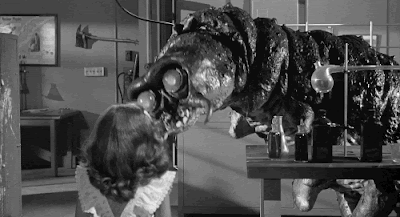
- Next, shift Twill over to the lab to discover that a hatched mollusc has Gail and Sandy cornered in a closet as it chews through the door.
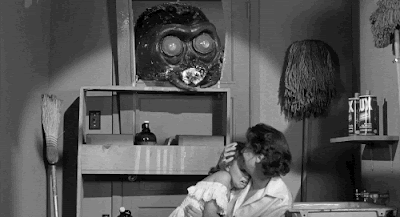
- Pour Twill into the action by getting him to fight the creature with lab chemicals and a CO2 fire extinguisher, giving Gail and Sandy a chance to escape the closet.

- Sprinkle into the lab an assortment of Navy personnel with guns to finally dispatch the mollusc.
- When the stew is ready, serve with a dollop of predictable sentimental happy ending with Twill carrying Sandy out of the lab and Gail walking beside them. Close with the three of them walking towards the camera and away from the lab building, destined to live happily ever after as a family.
Bon
Apetit!
Points of Interest
David Duncan who wrote the story for The Monster That Challenged the World also wrote scripts for The Time Machine (1960) and Fantastic Voyage (1966)Filming took place in 16 days with most of the underwater scenes shot at Catalina Island off the coast of Los Angeles. Close-ups were later filmed in a tank filled with water and plastic seaweed.
The film’s story is well-structured and the pace of the first half of the film is quite good. Thereafter, it does seem to drag on a bit until the final climax.
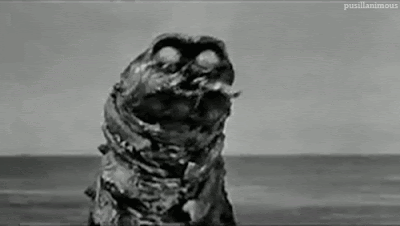
Sci-Fi Film Stew?!
The rather loose use of the recipe format for presenting the film was undertaken in order to highlight some the limiting and restrictive aspects that conventional systems can have on the way we view the world and our place in it. Such systems may cover the arts, politics, education, science, economics and more.
To an extent, we need to have some order and structure and agreed methods and criteria with which to describe, categorize and explain existence, our world and the universe. How else can we expect to live, to survive or exist?
The problem arises when the systems (any system!) we create to achieve the above serve to restrict innovative, unconventional and radical thought and action by erecting walls of conservatism, convention, and orthodoxy. Only certain specified and approved ingredients are prescribed. Preparation and cooking time are predetermined and set. Only approved procedures are to be followed to the letter and not deviated from.
The end result of this is that we wind up having such things as films, literature and so on slotted neatly into genre boxes with the end product being conservative, predictable, formulaic and shallow. No matter where we are in the world, as we keep on slavishly following the recipes set down for us, before we know it our own thinking becomes conservative, predictable, formulaic, shallow and closed to other possibilities.
Sometimes you just need to rip up the recipe, gather your own ingredients, formulate your own method, share the results with others and……challenge the world!


No comments:
Post a Comment